Step Back in Time: The Enigmatic Yumen Pass Ruins Await You
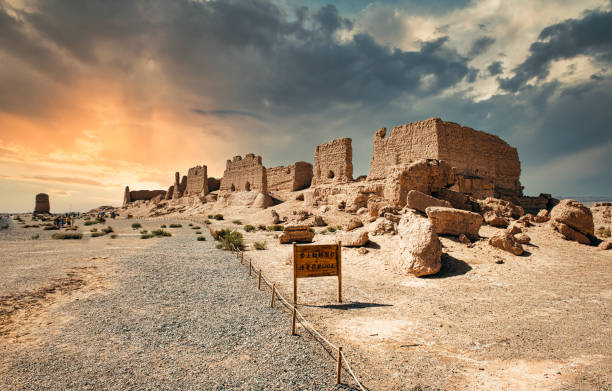
An Essential Guide to Visiting Yumen Pass Ruins
Nestled in the arid expanse of the Gobi Desert, Yumen Pass Ruins, also known as the Jade Gate Pass, stand as a poignant testament to the rich tapestry of history woven along the ancient Silk Road. This remarkable site, located approximately 90 kilometers northwest of Dunhuang, was once a vital checkpoint that separated the vast expanse of China from the mysterious lands beyond—an entrance for traders, travelers, and adventurers seeking fortune and knowledge in a world that thrived on commerce and cultural exchange.
As you stroll through the remnants of this once-bustling pass, you can almost hear the echoes of caravans laden with silk, spices, and stories, as they traversed the arid landscape. The ruins, dating back over 2,000 years to the Han Dynasty, offer a glimpse into a time when this strategic location played a crucial role in connecting East and West. Here, the desolate beauty of the surrounding landscape contrasts sharply with the historical significance of the structures that remain.
Visiting Yumen Pass is not just an exploration of ancient architecture; it’s an immersive journey into the past, where each stone tells a story, and the vast skies inspire a sense of wonder. With a well-organized visitor experience that includes an informative museum and an audio guide that enhances your understanding of the site, your adventure at Yumen Pass Ruins promises to be both enlightening and unforgettable. Whether you’re a history aficionado or a curious traveler seeking unique experiences, this storied location invites you to walk in the footsteps of those who once ventured through its gates.
In This Guide
- An Essential Guide to Visiting Yumen Pass Ruins
- The Rich History and Legends of Yumen Pass Ruins
- Main Highlights: What You Absolutely Can’t Miss
- Planning Your Visit: A Practical Guide
- Tickets: Prices, Booking, and Tips
- How to Get There: A Complete Transportation Guide
- Local Cuisine and Accommodation Nearby
- Frequently Asked Questions
- Final Thoughts on Your Trip
The Rich History and Legends of Yumen Pass Ruins
Nestled in the arid expanses of the Gobi Desert, the Yumen Pass Ruins (玉门关遗址) serve as a poignant reminder of the rich tapestry of history woven along the ancient Silk Road. This strategic checkpoint, known as the Jade Gate, has been a silent witness to the ebb and flow of trade, culture, and human endeavor for over two millennia.
Historical Significance
Constructed during the Han Dynasty around 121 BC, Yumen Pass was one of the critical gateways connecting the eastern part of China to the western territories, acting as a vital conduit for merchants, travelers, and diplomats. It was here that caravans would gather, laden with silk, spices, and other treasures, preparing to embark on their arduous journeys across treacherous terrain. The pass not only facilitated commerce but also cultural exchanges, allowing ideas and innovations to flow between civilizations.
The ruins themselves, though modest in their remains, echo tales of a bustling outpost that once thrived in this desolate landscape. Remnants of fortifications, watchtowers, and the ancient Han Great Wall still stand, offering modern visitors a glimpse into the architectural prowess of the time. These structures were designed to safeguard against invasions and to control the movement of goods and people, underscoring the pass’s importance as both a military and trade stronghold.
Legends and Lore
Beyond its historical significance, Yumen Pass is steeped in legends that have captivated the imagination of poets and historians alike. The site is often referenced in Tang Dynasty poetry, where it symbolizes both the beauty and the hardships of travel. The desolate beauty of the surrounding landscape, punctuated by the ghostly echoes of a once-thriving settlement, evokes a sense of nostalgia and romance for the intrepid explorers of old.
One poignant legend speaks of the “Lost Caravan,” a group of merchants who, despite their best efforts, vanished into the vast desert sands, leaving only whispers of their journey behind. Such tales enrich the experience of visiting the ruins, inviting travelers to ponder the stories and lives that converged here.
Visiting the Ruins
Today, the Yumen Pass Ruins stand as a testament to the enduring legacy of the Silk Road. Visitors can explore the remnants of the ancient gate, wander through the site’s museum, and absorb the breathtaking views of the surrounding desert. The ruins are easily accessible from Dunhuang, making it a popular stop for those seeking to connect with China’s storied past.
An audio guide enhances the experience, providing context and bringing to life the stories that echo through the ages. With the vast landscape stretching out before you, it’s easy to imagine the vibrant life that once filled this now quiet pass. Whether you are a history enthusiast or simply curious about the past, Yumen Pass offers a unique opportunity to step back in time and walk in the footsteps of ancient traders and travelers who once ventured through this remarkable gateway.
In sum, the Yumen Pass Ruins are more than just remnants of stone; they are a portal to a time when the world was interconnected in ways that resonate even today. As you stand amidst the ruins, let your imagination roam free, and feel the allure of the Silk Road’s rich history and the legends that continue to inspire.
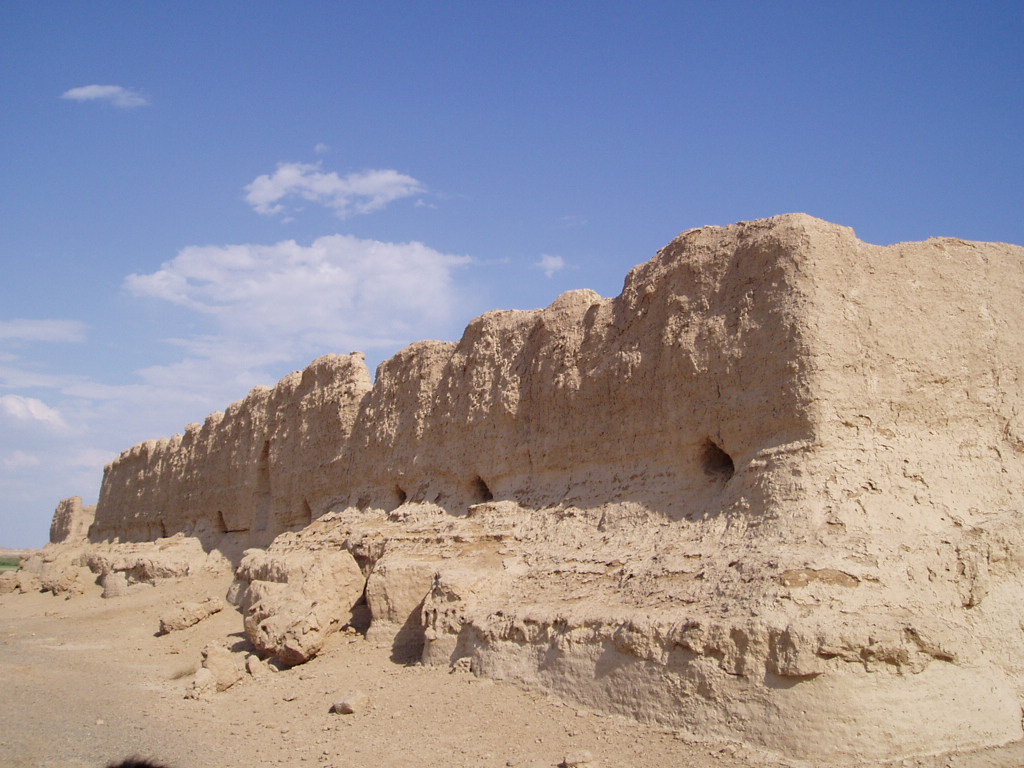
Yumen Pass Ruins.
Main Highlights: What You Absolutely Can’t Miss
Visiting the Yumen Pass Ruins is like stepping back in time to an era when this ancient checkpoint served as a bustling gateway along the Silk Road. Here are the main highlights you absolutely can’t miss during your visit:
The Jade Gate (Yumen Gate)
Start your exploration at the iconic Jade Gate, the remnants of which stand as a testament to the strategic importance of this site during the Han Dynasty. Once a vital entry point into China, the gate offers a glimpse into the past when caravans laden with goods would pass through. Walking distance from the museum, it’s an essential photo opportunity against the stunning backdrop of the Gobi Desert.
The Museum of Yumen Pass
Before heading out to the ruins, take some time to visit the onsite museum. It houses fascinating exhibits detailing the history of the Yumen Pass and its role in the Silk Road trade network. The museum also provides context for the ruins you’ll see later, enhancing your understanding of this historic site.
Scenic Ruins and Fortifications
As you wander the area, explore the various fortifications and ruins that remain. These remnants, including parts of the ancient Han Great Wall, allow you to visualize the once-thriving settlement that protected and facilitated trade. The vast landscape surrounding the ruins is equally captivating, inviting contemplation of the travelers who once traversed these arid lands.
Audio Guide Experience
To enrich your visit, consider renting the audio guide available at the entrance. This interactive feature uses GPS technology to provide location-based commentary, making it a valuable companion as you explore. Visitors have noted its informative nature, giving insights that deepen your appreciation for the historical significance of the site.
Breathtaking Views
The Yumen Pass is not only a historical site but also a place of stunning natural beauty. Climb to the viewing platforms and take in the sweeping vistas of the surrounding desert and distant mountains. The tranquility of the landscape enhances the historical ambiance, making for a memorable experience.
Nearby Attractions
If time permits, don’t miss the nearby Yangguan Pass, another landmark of the Silk Road. It’s a short journey from Yumen Pass and offers similar historical significance along with its own unique scenic views.
Practical Tips
- Timing Your Visit: The site is open daily from 8:00 AM to 6:00 PM. Plan to spend about 2-3 hours here to fully soak in the sights.
- Transportation: A bus service operates between key points within the area, allowing you to easily navigate between the gate, museum, and ruins.
With its rich history and breathtaking scenery, Yumen Pass Ruins provides an unforgettable experience for travelers eager to connect with the ancient Silk Road.
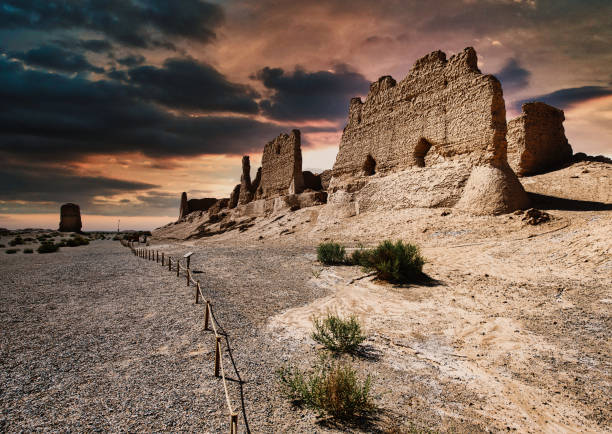
Yumen Pass Ruins.
Planning Your Visit: A Practical Guide
Your Comprehensive Guide to Visiting Yumen Pass Ruins
Embarking on a journey to the Yumen Pass Ruins (玉门关遗址) is like stepping back in time to the heart of the ancient Silk Road. Nestled approximately 90 kilometers northwest of Dunhuang, this historical site offers a glimpse into the past, where caravans once traversed between East and West. To ensure you make the most of your visit, here’s a practical guide to help you navigate this fascinating locale.
Getting There
Location:
Yumen Pass is located about 90 kilometers northwest of Dunhuang, making it accessible by car or bus. The journey typically takes around an hour.
Transportation Options:
– Private Car: Renting a car or hiring a driver can provide flexibility in your schedule and allow you to explore at your own pace.
– Tour Services: Consider joining a guided tour that includes Yumen Pass along with other sites like the Mogao Caves. This is a great option for travelers who prefer a structured itinerary.
– Public Bus: There are buses that run from Dunhuang to Yumen Pass, but it’s essential to check the current schedules as they can vary.
Entrance Fees and Hours
Opening Hours:
Yumen Pass is open daily from 8:00 AM to 6:00 PM. Arriving early will help you avoid crowds, especially during peak tourist seasons.
Entrance Fees:
The entrance fee is relatively modest, typically around 40 Yuan. Note that you might need to purchase a bus ticket separately if you wish to visit multiple sites within the area.
What to Expect
Audio Guide:
An audio guide is available at the entrance in multiple languages, including English. It features GPS functionality that plays relevant information based on your location, enhancing your understanding of the site’s historical context.
Site Highlights:
– The Gate: The remnants of the ancient gate are within walking distance from the museum. This was once a crucial checkpoint on the Silk Road, and standing before it evokes a sense of history.
– Museum: The on-site museum provides detailed information about the history and significance of Yumen Pass, making it a worthwhile stop before exploring the ruins.
– Remnants of the Great Wall: Explore the ruins of the Han Great Wall and other fortifications that date back over 2,000 years. The desolate landscape adds to the site’s historical ambiance.
Nearby Attractions
While visiting Yumen Pass, consider exploring these nearby attractions:
– Yadan National Geological Park: Known for its unique rock formations and breathtaking landscapes, this park is just a short distance away.
– Yangguan Pass: Another historical site that offers a glimpse into the ancient Silk Road, often included in guided tours.
Tips for Your Visit
- Dress Appropriately: The region can be quite dry and hot during the day, so wear sun protection and bring plenty of water.
- Timing Your Visit: Sunset can create stunning views over the ruins, so plan to stay a little longer if you can.
- Language Barrier: While some staff speak basic English, having a translation app or phrasebook can be helpful for communication.
Duration of Visit
Plan to spend about 2-3 hours exploring Yumen Pass to fully appreciate its history and the surrounding landscapes. This timeframe allows for a leisurely visit to the museum, the gate, and the remnants of the Great Wall.
Yumen Pass Ruins is not just a destination; it’s a journey through time, offering rich historical insights and stunning vistas. Whether you’re a history buff or simply seeking a unique travel experience, this site is sure to leave a lasting impression. Enjoy your adventure along the ancient Silk Road!
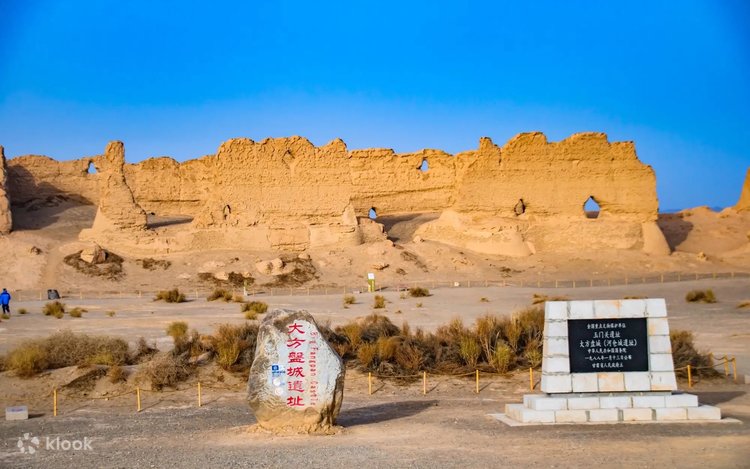
Yumen Pass Ruins.
Tickets: Prices, Booking, and Tips
When planning your visit to the Yumen Pass Ruins, it’s essential to know the ticketing details, including prices, booking options, and some handy tips to enhance your experience.
Ticket Information
- Entry Fee: The basic entrance ticket to the Yumen Pass site is approximately ¥40 (about $6 USD). This ticket grants you access to the museum and the surrounding ruins.
- Audio Guide: For a more enriching experience, consider renting an audio guide for ¥40. The guide is available in multiple languages, including English, and provides insights into the historical significance of the site as you explore.
- Bus Tickets: To visit the various sites within the Yumen Pass area, you will need to purchase a separate bus ticket. Buses run every 30 minutes to key locations, including the Han Great Wall and additional ruins. Make sure to buy this ticket at the entrance before boarding.
Booking Your Visit
- Advance Reservations: While tickets can typically be purchased on-site, booking in advance is advisable during peak tourist seasons. This can help to avoid long queues and ensure you have a spot on the bus for your desired itinerary.
- Guided Tours: If you prefer a structured experience, consider joining a guided tour. Several operators offer packages that include transportation, entrance fees, and a knowledgeable guide who can provide in-depth historical context.
Tips for an Enjoyable Visit
-
Plan Your Timing: The Yumen Pass is open daily from 8:00 AM to 6:00 PM. Arriving early in the day will help you beat the crowds and enjoy the serene beauty of the area.
-
Duration: Allocate at least 2 to 3 hours for your visit to explore the main sites, including the museum and the various ruins. This timeframe allows for a leisurely pace and time to soak in the stunning desert landscapes.
-
Bring Water and Snacks: The area is quite remote, and amenities are limited. Carry plenty of water and some snacks, especially if you plan to spend an extended time exploring.
-
Dress Comfortably: Given the location in the Gobi Desert, wear comfortable shoes and dress in layers to accommodate temperature changes throughout the day. Sun protection like hats and sunscreen is also recommended.
-
Check for Audio Guide Availability: If you’re keen on using the audio guide, inquire about its availability upon arrival, as some visitors have reported challenges in obtaining one.
By keeping these points in mind, you can ensure a memorable visit to the historic Yumen Pass Ruins, where the remnants of ancient trade routes beckon you to explore their rich history.
How to Get There: A Complete Transportation Guide
Getting to the Yumen Pass Ruins, an ancient relic of the Silk Road, is an adventure in itself. Nestled approximately 90 km northwest of Dunhuang in the Gobi Desert, this historical site is accessible through various transportation options, making it easy for international travelers to immerse themselves in its rich history.
By Air
The nearest major airport is Dunhuang Airport (DNH), which receives both domestic and limited international flights. Once you arrive at the airport, you have several options to reach Yumen Pass:
- Airport Shuttle: Look for shuttle services that connect the airport to Dunhuang city. These shuttles operate at regular intervals.
- Taxi: Taxis are readily available at the airport. A direct ride to Yumen Pass will take about an hour and can be a convenient option if you’re traveling with a group.
By Train or Bus
If you prefer ground transportation, you can take a train or bus to Dunhuang from major cities like Lanzhou or Xi’an.
- Train: Dunhuang Railway Station is the closest station to Yumen Pass. Upon arrival, you can take a taxi to the Yumen Pass area.
- Long-Distance Bus: Buses to Dunhuang are available from various cities. Once in Dunhuang, you can use local transportation to get to Yumen Pass.
Local Transportation to Yumen Pass
Once you’re in Dunhuang, you have a couple of options to reach the Yumen Pass Ruins:
-
Public Bus: There is a public bus service that runs to Yumen Pass. The bus departs from the Dunhuang city center and typically operates every 30 minutes. Be sure to purchase your bus ticket separately from your entry ticket to the ruins.
-
Guided Tours: Consider joining a guided tour, which often includes transportation to Yumen Pass. This can be a great way to learn more about the history of the site while ensuring a hassle-free experience.
By Car
If you’re feeling adventurous, renting a car gives you the flexibility to explore at your own pace. The drive from Dunhuang to Yumen Pass takes roughly one hour. The roads are generally in good condition, and having your own vehicle allows you to stop and take in the stunning desert landscapes along the way.
On Arrival
Upon arrival at Yumen Pass, you’ll find a well-organized visitor center. An audio guide is available for a small fee, providing you with insightful historical context about the ruins and their significance on the ancient Silk Road. The Yumen Gate itself is within walking distance of the museum, while shuttle buses connect visitors to nearby sites.
Final Tips
- Timing: The site is open from 8:00 AM to 6:00 PM, making it ideal for a half-day trip. Arriving early can help you avoid crowds and enjoy the peaceful surroundings.
- Bring Cash: While larger facilities in Dunhuang may accept cards, it’s wise to carry cash for smaller purchases or transport.
- Language: English may not be widely spoken among the local staff, so having a translation app or phrasebook can enhance your communication experience.
With these transportation options, your journey to the Yumen Pass Ruins will not only be straightforward but also a memorable part of your adventure along the Silk Road. Enjoy exploring this fascinating piece of history!

Yumen Pass Ruins.
Local Cuisine and Accommodation Nearby
When exploring the historical Yumen Pass Ruins, it’s essential to complement your visit with a taste of local cuisine and a comfortable place to stay nearby. Here are some recommendations that will enhance your experience in this fascinating part of China.
Local Cuisine
1. Dunhuang Night Market
Just a short drive from Yumen Pass, the Dunhuang Night Market is a must-visit for food lovers. Here, you can sample a variety of local dishes, including:
– Dunhuang Noodles (Dunhuang Mian): Hand-pulled noodles served in a savory broth, often topped with fresh vegetables and spices.
– Sizzling Lamb Skewers: A popular street food, these skewers are marinated with local spices and grilled to perfection.
– Jujube Dates: Often found in desserts, these sweet dates are native to the region and offer a delightful taste of local agriculture.
2. Laohu Restaurant (老虎餐厅)
Located in Dunhuang, Laohu Restaurant provides a cozy atmosphere with traditional interiors. The menu features:
– Dumplings: Juicy and flavorful, these dumplings are filled with a variety of meats and vegetables.
– Stir-Fried Vegetables: Fresh, seasonal vegetables stir-fried with garlic and spices, perfect for complementing your meal.
– Local Wines: Pair your dishes with some local wines, which can provide a unique flavor profile to your dining experience.
3. Dunhuang Beef Noodle House
For those who want to indulge in the region’s famous beef dishes, this place is a hidden gem. Their specialties include:
– Beef Noodle Soup: Rich broth with tender beef slices, served with hand-pulled noodles.
– Beef Pancakes: Crispy and flaky, these pancakes are stuffed with seasoned beef, making for a delicious snack.
Accommodation Nearby
1. Dunhuang International Hotel
A family-friendly option, this hotel offers comfortable rooms with modern amenities. It’s conveniently located about an hour’s drive from Yumen Pass, making it a great base for your adventures. The hotel features:
– Free Wi-Fi: Stay connected during your travels.
– On-site Restaurant: Enjoy a mix of local and international cuisine without leaving the hotel.
2. Silk Road Dunhuang Hotel
Embracing the spirit of the Silk Road, this hotel offers unique themed rooms inspired by the ancient trade route. Features include:
– Spa Services: Relax after a day of exploration with soothing spa treatments.
– Complimentary Breakfast: Start your day with a hearty breakfast featuring local specialties.
3. Dunhuang Yumen Hotel
A budget-friendly option close to the city center, perfect for travelers looking for simplicity and convenience. Amenities include:
– Clean, Comfortable Rooms: Ideal for resting after a long day of sightseeing.
– 24-Hour Front Desk: Helpful staff available to assist with your travel needs.
Final Thoughts
Your visit to Yumen Pass Ruins will be enriched by indulging in the local cuisine and retreating to comfortable accommodations. Whether savoring the flavors of the region or resting in a cozy hotel, you’ll find that this remarkable area offers more than just historical wonders—it’s a journey for the senses.
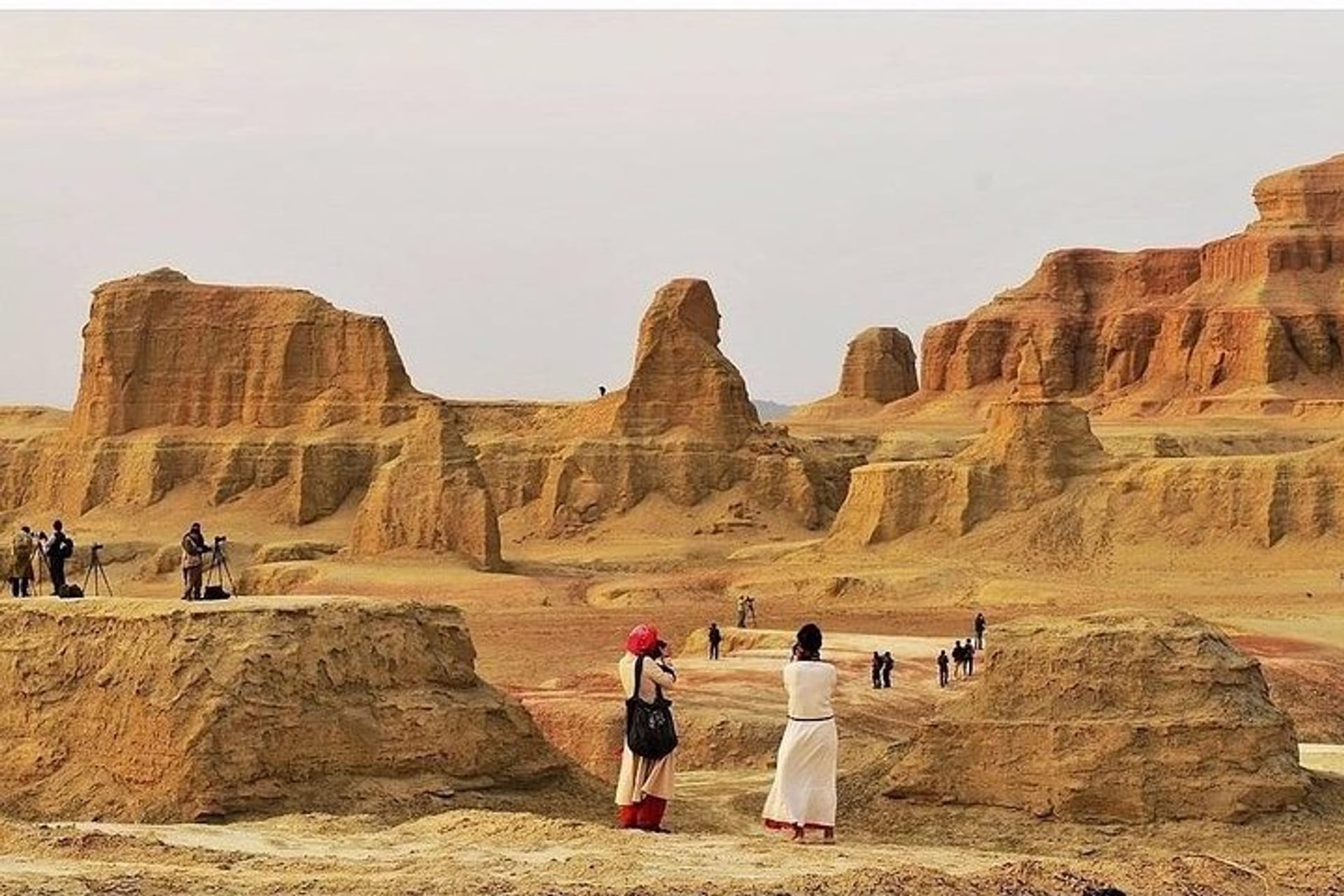
Yumen Pass Ruins.
Frequently Asked Questions
Frequently Asked Questions about Yumen Pass Ruins
1. What is Yumen Pass, and why is it historically significant?
Yumen Pass, also known as the Jade Gate, is an ancient checkpoint that served as a critical entry point along the Silk Road during the Han Dynasty. It marked the boundary between China and the western regions, facilitating trade and cultural exchange for over 2,000 years.
2. How do I get to Yumen Pass from Dunhuang?
Yumen Pass is located approximately 90 kilometers northwest of Dunhuang. You can take a taxi or join a guided tour, which often includes transportation. The journey typically takes around an hour.
3. What are the opening hours for Yumen Pass?
Yumen Pass is open daily from 8:00 AM to 6:00 PM. It’s recommended to arrive early to make the most of your visit.
4. Is there an entrance fee, and what does it include?
Yes, there is an entrance fee of approximately 40 Yuan (around $6). This fee grants you access to the main site, and you may need to purchase an additional bus ticket to visit nearby attractions like the Han Great Wall and other ruins.
5. Are there guided tours or audio guides available?
Yes, an audio guide is available for rent at the entrance, offering informative commentary in English and other languages. Guided tours can also be arranged, providing deeper insights into the history and significance of the site.
6. How much time should I allocate for my visit?
Plan to spend around 2 to 3 hours at Yumen Pass. This will give you enough time to explore the ruins, visit the museum, and enjoy the surrounding scenery.
7. What should I bring when visiting Yumen Pass?
Wear comfortable shoes for walking and bring water, sunscreen, and a hat, as the area can be quite exposed and hot. Don’t forget your camera to capture the stunning landscapes and historical remnants!
8. Are there facilities like restrooms or food options on-site?
Basic facilities, including restrooms, are available near the entrance. However, dining options are limited, so it’s a good idea to bring snacks or plan to eat in Dunhuang before or after your visit.
Final Thoughts on Your Trip
As you reflect on your journey to the Yumen Pass Ruins, take a moment to appreciate the deep historical significance of this remarkable site. Once a vibrant gateway along the Silk Road, it served as a crucial checkpoint that bridged civilizations and cultures, echoing the footsteps of countless travelers who dared to venture into the unknown. The remnants of the ancient fortifications and the haunting beauty of the Gobi Desert surrounding you are not just relics of the past; they are windows into an era where trade flourished and stories were shared across vast distances.
With the backdrop of stunning landscapes and the tranquil aura of the ruins, this destination offers more than just sightseeing; it invites you to engage with history and imagine the lives of those who once traversed this route. Whether you marveled at the gate itself, explored the museum, or took in the panoramic views, your experience at Yumen Pass is sure to resonate long after your visit.
So as you pack your bags and continue your travels, carry with you the spirit of adventure that the Yumen Pass embodies. May it inspire you to seek out more hidden gems along the Silk Road and beyond, reminding you that every journey is a chance to connect with the past and discover new horizons. Safe travels!